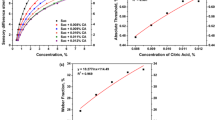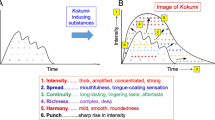Abstract
THE ordinary form of most reducing sugars, such as α-glucose, β-fructose and α-galactose, becomes gradually less sweet after dissolution, and in the meantime the sweetness reaches a constant value, since the ordinary form is converted in part into the less sweet isomer, and finally an equilibrium is attained between the two isomers: α⇌β.
This is a preview of subscription content, access via your institution
Access options
Subscribe to this journal
Receive 51 print issues and online access
$199.00 per year
only $3.90 per issue
Buy this article
- Purchase on Springer Link
- Instant access to full article PDF
Prices may be subject to local taxes which are calculated during checkout
Similar content being viewed by others
References
Tsuzuki, Y., Kagaku (Science), 17, 342 (1947) (in Japanese).
Tsuzuki, Y., and Yamazaki, J., Biochem. Z., 323, 525 (1953).
Author information
Authors and Affiliations
Rights and permissions
About this article
Cite this article
TSUZUKI, Y., MORI, N. Sweetness and Configuration in Rhamnose. Nature 174, 458–459 (1954). https://doi.org/10.1038/174458b0
Issue Date:
DOI: https://doi.org/10.1038/174458b0
This article is cited by
-
Cytotoxic Plumbagin-5-O-α-l-Rhamnopyranoside from Plumbago indica
Revista Brasileira de Farmacognosia (2021)
Comments
By submitting a comment you agree to abide by our Terms and Community Guidelines. If you find something abusive or that does not comply with our terms or guidelines please flag it as inappropriate.



